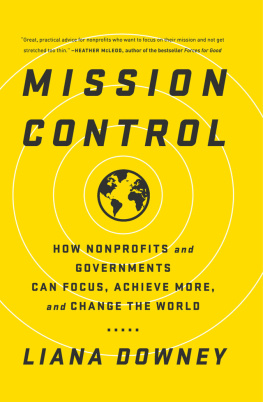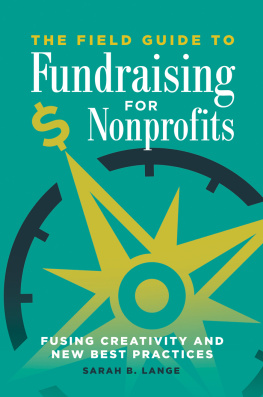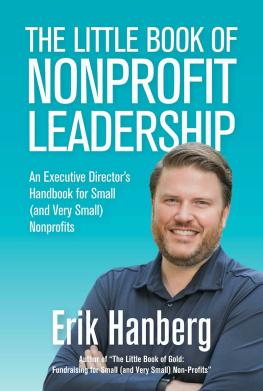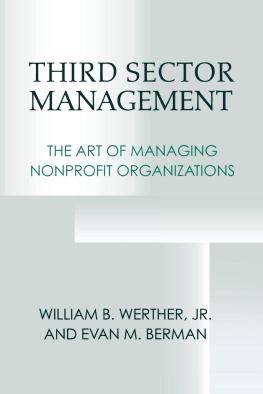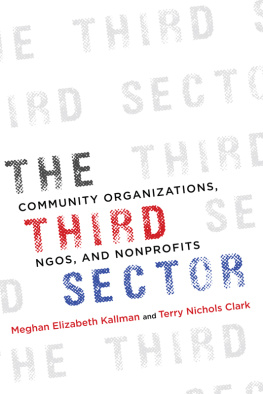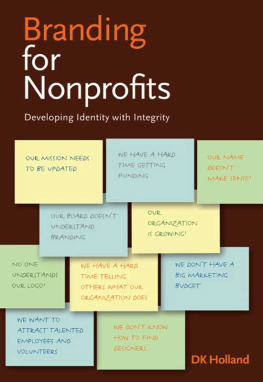MISSION CONTROL
"Mission Control is an exciting and timely challenge to nonprofits and government organizations to revisit their mission and regain focus. Liana Downey shows leaders how to reset aspirations at a high level, to inspire and genuinely make a difference to the lives of those they serve."
-ROBERT M c LEAN , director emeritus, McKinsey & Company, and chair, The Nature Conservancy Australia
"Focus, facts, stakeholders, strategy Mission Control leads you through all of these basics and other critical elements, wisely not glibly If you're new to the arena of social change, read it, if you're a veteran, refresh on it."
-PETER GOLOMARK, former CEO, Rockefeller Foundation, and chairman and CEO of the International Herald Tribune
"This book doesn't only tell you what to do, it patiently takes you through how to do it: nonprofit strategy in a nutshell, minus the oversimplifications and dogmatic frameworks upon which many lesser efforts are built."
-TOM RIPPIN, CEO and founder, On Purpose [UK, France]
Liana is a true leader who brings rare clarity and insight that helps government and community organizations define and achieve their mission. Mission Control is more than a must-read, its a practical tool to enable many more leaders to translate their intentions and effort into clearly realized impact for the benefit of people and communities.
ROSEMARY ADDIS, founder and chair, Impact Investing Australia
Mission Control
How Nonprofits and Governments can Focus, Achieve More, and Change the World
Liana Downey
First published 2016 by Bibliomotion, Inc.
Published 2016 by Routledge
711 Third Avenue, New York, NY 10017 USA
2 Park Square, Milton Park, Abingdon, Oxon OX14 4RN
Routledge is an imprint of the Taylor & Francis Group, an informabusiness
Copyright 2016 by Liana Downey
All rights reserved. No part of this book may be reprinted or reproduced or utilized in any form or by any electronic, mechanical, or other means, now known or hereafter invented, including photocopying and recording, or in any information storage or retrieval system, without permission in writing from the publishers.
ISBN-13: 9781629561233 (hbk)
ISBN-13: 9781315230146 (ebk)
Library of Congress Cataloging-in-Publication Data
Names: Downey, Liana, author.
Title: Mission control : how nonprofits and governments can focus, achieve more, and change the world / Liana Downey.
Description: First Edition. | Brookline, MA : Bibliomotion, 2016.
Identifiers: LCCN 2016002306 (print) | LCCN 2016006259 (ebook) | ISBN 9781629561233 (hardback) | ISBN 9781629561240 (eBook) | ISBN 9781629561257 (enhanced eBook)
Subjects: LCSH: Nonprofit organizationsManagement. | BISAC: BUSINESS & ECONOMICS/Nonprofit Organizations & Charities. | BUSINESS & ECONOMICS/ Structural Adjustment.
Classification: LCC HD62.6 .D69 2016 (print) | LCC HD62.6 (ebook) | DDC 658/.048dc23
LC record available at http://lccn.loc.gov/2016002306
For my familyI love you, a lot; and for all the leaders working hard to create a better worldthose I have had the pleasure of working with, and those I have yet to meet, this ones for you.
It has been described as "one of the noblest and best things we have ever done as a species"stopping one of humankind's most gruesome killers, globally feared and responsible for the deaths of more than half a billion people. It was an incredible feat, D.A. Henderson, an American physician and epidemiologist, led the charge to eradicate smallpox with the help of hundreds of thousands of people around the world, from illiterate workers in rural villages to specialist surgeons. It is hard today to grasp the scale of this undertaking, its urgency and importance. Very few of us remember or understand just how brutal and devastating smallpox was. This heroic feat required innovation and collaboration. But most of all, it required focus. After years of discussing the possibility, the World Health Organization set a ten-year goal in 1967 to eradicate smallpoxa goal known as Target Zero (zero cases of smallpox). The goal seemed outrageousinconceivable. It was also spine-tingling and, critically, a goal focused on outcomes. "Target Zero,.. emphasized that the goal was not millions of vaccinations but zero cases of smallpox," noted Henderson. Ten years later, the last known case of smallpox was recorded, and in 1980 smallpox was declared eradicated, saving sixty million lives and counting.
Why do some leaders succeed in changing the world while others struggle to point to their impact? What links the eradication of smallpox, the housing of one hundred thousand homeless Americans, and the dramatic reduction in drunk-driving fatalities? The leaders of these efforts shared a laser-like focus on their respective goals.
These leaders discovered the power of making the choice to be something to someone, rather than trying to be everything to everyone. Organizations that change the world share one critical feature. They systematically identify and target their efforts in their sweet spotthe intersection between what they are good at, what the world needs, and what works.
Why are Missions Out of Control?
Does your organization lack focus? If so, you are not alone. Missions get out of control for three reasons. First, organizations are operating in an increasingly competitive funding environment. Second, many programs start by addressing symptoms rather than root causes. Finally, most social sector leaders have a hard time saying no. The result is mission creep, and with it, diluted impact and exhausted leaders.
The demand for nonprofit and public services is growing at an incredible pace around the world, but as the size of the sector grows, so does the competition for funding. This means many organizations follow the money. Perhaps an organization exists to raise funds for prostate cancer research, but finds out that there is a grant for raising awareness about the disease. The organization needs the resources, and this seems somewhat related, so without too much soul-searching it bids and succeeds. Over time, the organizations leaders continue to do this, adding services, and before they know it the nonprofit has moved from being a research-funding organization to being a direct-service, awareness-raising, lobbying, and research-funding organization. This is not inherently a bad thing, but if its initial focus was to research cures for prostate cancer, and its efforts have been pulled in multiple different directions, the result is mission creep, lost focus, and potentially diluted impactand how much closer is a cure?
Many organizations start their lives with a narrow focus or activity in response to a clear need. Consider a food pantry. Perhaps a group of individuals in the local community notice that they have neighbors who are going hungry. They get together and start providing food to those in need. Before long, it becomes apparent that many of the people who are coming for food have other needshousing, clothing, employment, and so on. So the food pantry starts offering referrals to homeless shelters and collecting clothing donations to give to its clients. They start providing job training. While all these activities are useful and worthwhile, what is not clear is whether this food pantry is the best organization to be meeting these needs. It has gone wide in its services, and certainly helped people along the way. But has this increase in the breadth of services enabled it to better meet the initial need? Are there still people in its community going hungry?

